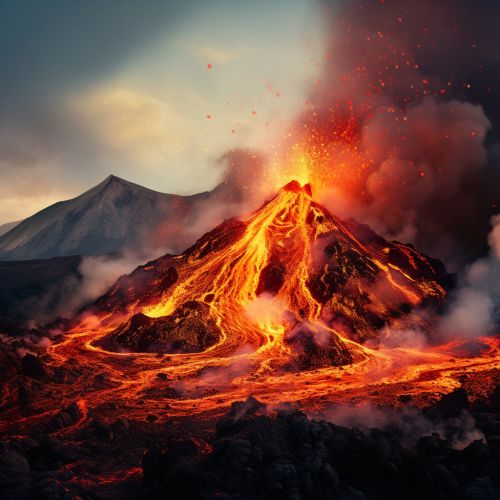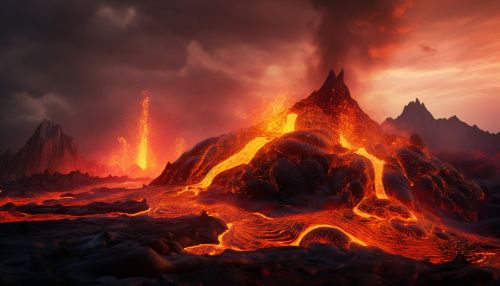Volcanic Eruption
Introduction
A volcanic eruption is a geological event marked by the release of magma, gas, and other materials from a volcano's interior to the Earth's surface. This process is driven by the buoyancy of the magma and the pressure exerted by the gases dissolved within it. Volcanic eruptions are one of the most powerful and destructive natural phenomena, capable of causing widespread devastation and loss of life. However, they also play a crucial role in shaping the Earth's landscape and influencing its climate.
Types of Volcanic Eruptions
Volcanic eruptions can be classified into several types based on their intensity, the nature of the ejected materials, and the form of eruption. The most common types include effusive eruptions, explosive eruptions, and phreatomagmatic eruptions.
Effusive Eruptions
Effusive eruptions are characterized by the slow and steady flow of low-viscosity magma from a volcano. This type of eruption typically occurs when the magma is rich in basalt, a type of rock that melts at relatively low temperatures and has a low gas content. The resulting lava flows can cover large areas and create new landforms, such as shield volcanoes and lava plateaus.


Explosive Eruptions
In contrast, explosive eruptions involve the violent discharge of high-viscosity magma and gases. This type of eruption is often associated with magma that is rich in silica, a mineral that increases the magma's viscosity and gas content. The most notable examples of explosive eruptions are Plinian eruptions, named after Pliny the Younger who documented the eruption of Mount Vesuvius in 79 AD.
Phreatomagmatic Eruptions
Phreatomagmatic eruptions occur when magma comes into contact with water, causing a rapid expansion of steam that leads to an explosive eruption. This type of eruption can occur in various settings, such as when a volcano erupts beneath a glacier or a body of water, or when groundwater seeps into a volcanic conduit.
Mechanisms of Volcanic Eruptions
The mechanisms of volcanic eruptions are complex and involve a number of physical and chemical processes. These include the generation of magma, its ascent through the Earth's crust, and its ejection onto the surface.
Magma Generation
Magma generation occurs in the Earth's mantle and crust, where heat and pressure cause rocks to melt. The composition of the magma depends on the type of rocks that are melted and the depth at which melting occurs. For instance, melting of mantle rocks typically produces basaltic magma, while melting of crustal rocks can produce andesitic or rhyolitic magma.
Magma Ascent
The ascent of magma from its source to the surface is driven by the buoyancy of the magma and the pressure of the gases dissolved within it. As the magma rises, the pressure decreases, causing the dissolved gases to expand and form bubbles. This process, known as magma degassing, can trigger a volcanic eruption if the gas pressure exceeds the strength of the overlying rocks.
Eruption
The eruption process involves the ejection of magma, gases, and other materials onto the Earth's surface. The nature of the eruption depends on the viscosity of the magma, the gas content, and the conduit structure. For instance, low-viscosity magma can lead to effusive eruptions, while high-viscosity magma can lead to explosive eruptions.
Impacts of Volcanic Eruptions
Volcanic eruptions can have both destructive and beneficial impacts. On the one hand, they can cause loss of life and property, disrupt transportation and communication networks, and affect the environment and climate. On the other hand, they can create new landforms, enrich soils with nutrients, and provide geothermal energy.
Destructive Impacts
The destructive impacts of volcanic eruptions include pyroclastic flows, lahars, volcanic gases, and ashfall. Pyroclastic flows are fast-moving currents of hot gas and volcanic matter that can destroy everything in their path. Lahars are mudflows or debris flows composed of water and volcanic material, which can bury communities located downstream of a volcano. Volcanic gases, such as sulfur dioxide, can cause air pollution and acid rain. Ashfall can damage buildings, contaminate water supplies, and disrupt air travel.
Beneficial Impacts
Despite their destructive power, volcanic eruptions also have beneficial impacts. They create new landforms, such as islands and mountains, and enrich soils with volcanic ash, which is rich in nutrients. Volcanic eruptions also provide geothermal energy, a renewable source of power that can be harnessed for electricity generation.
Conclusion
Volcanic eruptions are complex geological events that can have both destructive and beneficial impacts. Understanding the mechanisms and impacts of volcanic eruptions is crucial for mitigating their risks and harnessing their benefits. As our knowledge of volcanoes continues to grow, so does our ability to predict and respond to these powerful natural phenomena.
